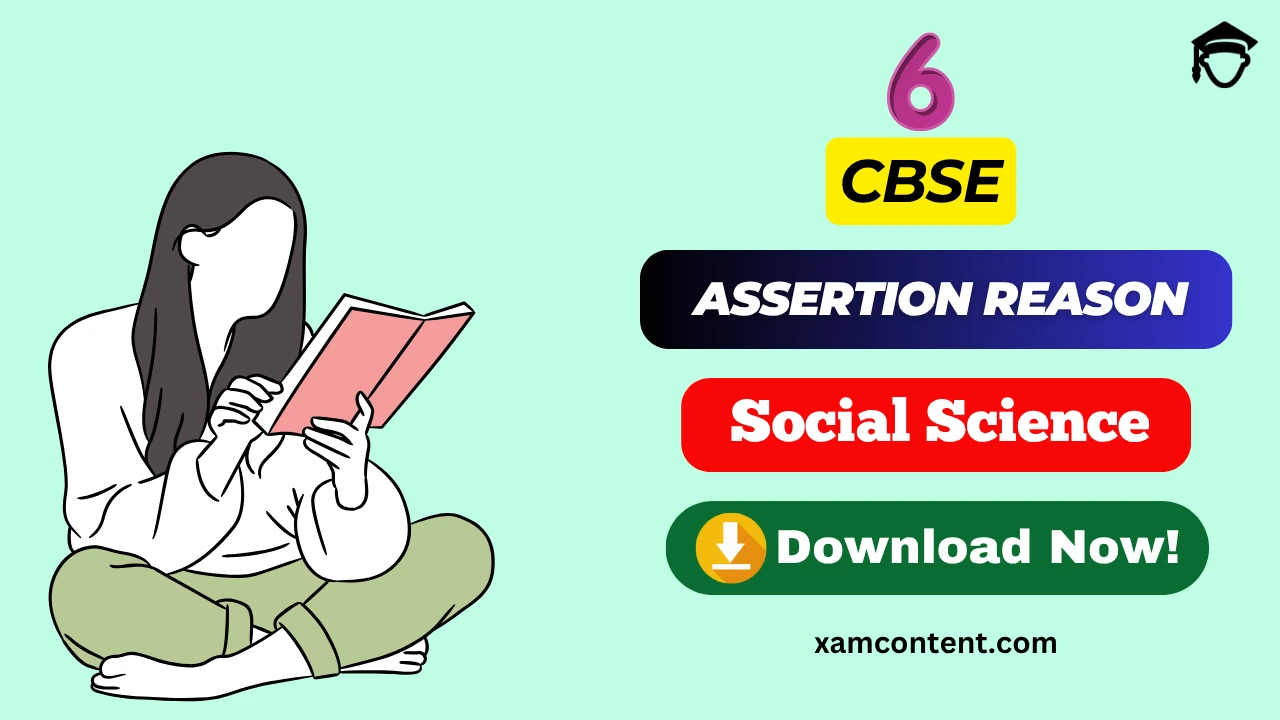Last Updated on November 16, 2025 by XAM CONTENT
Hello students, we are providing assertion reason questions for class 6. Assertion Reason questions are the new question format that is introduced in CBSE board. The resources for assertion reason questions are very less. So, to help students we have created chapterwise assertion reason questions for class 6 Social Science. In this article, you will find assertion reason questions for CBSE Class 6 Social Science Chapter 6 The Beginings of Indian Civilisation. It is a part of Assertion Reason Questions for CBSE Class 6 Social Science Series.
| Chapter | The Beginings of Indian Civilisation |
| Type of Questions | Assertion Reason Questions |
| Nature of Questions | Competency Based Questions |
| Board | CBSE |
| Class | 9 |
| Subject | Social Science |
| Useful for | Class 6 Studying Students |
| Answers provided | Yes |
| Difficulty level | Mentioned |
| Important Link | Class 6 Social Science Chapterwise Assertion Reason |
Assertion Reason Questions on The Beginings of Indian Civilisation
Q1. Assertion (A): The Indus Valley Civilization developed along the river Indus and its tributaries.
Reason (R): Fertile alluvial soil and availability of water supported agriculture.
(a) Both A and R are true and R is the correct explanation of A.
(b) Both A and R are true but R is not the correct explanation of A.
(c) A is true but R is false.
(d) A is false but R is true.
Show Answer
Ans: (a)
Explanation: Both statements are true and connected; the river system enabled irrigation and fertile farmlands for early settlement.
Q2. Assertion (A): Harappa and Mohenjo-Daro were the only cities of the Indus Valley Civilization.
Reason (R): Other important sites include Lothal, Kalibangan, and Dholavira.
(a) Both A and R are true and R is the correct explanation of A.
(b) Both A and R are true but R is not the correct explanation of A.
(c) A is true but R is false.
(d) A is false but R is true.
Show Answer
Ans: (d)
Explanation: The assertion is false; several other urban centers were part of the civilization beyond Harappa and Mohenjo-Daro.
Q3. Assertion (A): The people of the Indus Valley used baked bricks to build their houses.
Reason (R): These uniform bricks indicate a high level of town planning.
(a) Both A and R are true and R is the correct explanation of A.
(b) Both A and R are true but R is not the correct explanation of A.
(c) A is true but R is false.
(d) A is false but R is true.
Show Answer
Ans: (a)
Explanation: Both statements are true and related; standardized bricks show organized civic planning and central authority.
Q4. Assertion (A): The Great Bath at Mohenjo-Daro was likely used for private bathing.
Reason (R): It is believed to have had a religious or ceremonial purpose.
(a) Both A and R are true and R is the correct explanation of A.
(b) Both A and R are true but R is not the correct explanation of A.
(c) A is true but R is false.
(d) A is false but R is true.
Show Answer
Ans: (d)
Explanation: The reason is true—most scholars believe it was used for rituals—so the assertion is false.
Q5. Assertion (A): Seals found in the Indus Valley contain pictorial scripts that remain undeciphered.
Reason (R): They suggest trade, administration, and religious symbolism.
(a) Both A and R are true and R is the correct explanation of A.
(b) Both A and R are true but R is not the correct explanation of A.
(c) A is true but R is false.
(d) A is false but R is true.
Show Answer
Ans: (a)
Explanation: Both are true and linked; seals reveal the civilization’s administrative and economic sophistication.
Q6. Assertion (A): The Indus Valley people were primarily hunters and gatherers.
Reason (R): They cultivated crops like wheat, barley, and pulses.
(a) Both A and R are true and R is the correct explanation of A.
(b) Both A and R are true but R is not the correct explanation of A.
(c) A is true but R is false.
(d) A is false but R is true.
Show Answer
Ans: (d)
Explanation: The assertion is false; agriculture was the main occupation supported by fertile plains and irrigation.
Q7. Assertion (A): Lothal was an important port city of the Indus Valley Civilization.
Reason (R): It had a dockyard that connected the city to sea trade routes.
(a) Both A and R are true and R is the correct explanation of A.
(b) Both A and R are true but R is not the correct explanation of A.
(c) A is true but R is false.
(d) A is false but R is true.
Show Answer
Ans: (a)
Explanation: Both are true and related; archaeological evidence supports Lothal as a maritime trade center.
Q8. Assertion (A): Decline of the Indus Valley Civilization was sudden and caused by a single natural disaster.
Reason (R): Multiple factors like floods, climatic change, and invasions contributed to its decline.
(a) Both A and R are true and R is the correct explanation of A.
(b) Both A and R are true but R is not the correct explanation of A.
(c) A is true but R is false.
(d) A is false but R is true.
Show Answer
Ans: (d)
Explanation: The assertion is false; historians attribute the decline to combined environmental and human factors.
We hope the given assertion reason questions with Answers for The Beginings of Indian Civilisation Class 6 helps you in your learning.

Also check
- Class 6 Social Science Assertion Reason Questions Chapter 14 – Economic Activities Around Us
- Class 6 Social Science Assertion Reason Questions Chapter 13 – The Value of Work
- Class 6 Social Science Assertion Reason Questions Chapter 12 – Grassroots Democracy Part 3 Local Government in Urban Areas
- Class 6 Social Science Assertion Reason Questions Chapter 11 – Grassroots Democracy Part 2 Local Government in Rural Areas
- Class 6 Social Science Assertion Reason Questions Chapter 10 – Grassroots Democracy Part 1 Governance
- Class 6 Social Science Assertion Reason Questions Chapter 9 – Family and Community
- Class 6 Social Science Assertion Reason Questions Chapter 8 – Unity in Diversity
- Class 6 Social Science Assertion Reason Questions Chapter 7 – India’s Cultural Roots
- Class 6 Social Science Assertion Reason Questions Chapter 6 – The Beginings of Indian Civilisation
- Class 6 Social Science Assertion Reason Questions Chapter 5 – India, that is Bharat
- Class 6 Social Science Assertion Reason Questions Chapter 4 – Timeline and Sources of History
- Class 6 Social Science Assertion Reason Questions Chapter 3 – Landforms and Life
- Class 6 Social Science Assertion Reason Questions Chapter 2 – Ocean and Continents
- Class 6 Social Science Assertion Reason Questions Chapter 1 – Locating Places on Earth
Topics from which assertion reason questions may be asked
- Definition and features of a civilisation
- The Indus-Sarasvatī Civilisation – major sites and findings
- Town planning, trade, crafts and culture
Assertion reason questions from the above given topic may be asked.

You may also like

Frequently Asked Questions (FAQs) on The Beginings of Indian Civilisation Assertion Reason Questions Class 6
Q1: What are Assertion Reason Questions in Class 6 Social Science?
A1: Assertion Reason Questions are a new type of competency-based questions where students are given two statements — an Assertion (A) and a Reason (R). Students must decide whether each statement is true and whether the Reason correctly explains the Assertion.
Q2: How can Assertion Reason Questions help in exam preparation?
A2: These questions help students think critically, understand cause–effect relationships, and go beyond rote learning. They strengthen conceptual clarity in topics like History, Geography, and Civics by testing logical connections between facts.
Q3: How should students approach Assertion Reason Questions?
A3: Students should first read both statements carefully, identify whether each is true or false, and then check if the Reason actually explains the Assertion. Practicing chapter-wise Assertion Reason sets regularly improves accuracy and speed.
Q4: Are Assertion Reason Questions included in CBSE Class 6 syllabus?
A4: While Assertion Reason Questions are not directly mentioned in the NCERT syllabus, they are part of the new competency-based assessment pattern introduced by CBSE to promote conceptual understanding and analytical thinking.
Q5: What types of topics are covered in Class 6 Social Science Assertion Reason Questions?
A5: Topics include key chapters from History (e.g., What, Where, How and When?), Geography (e.g., The Earth in the Solar System), and Civics (e.g., Understanding Diversity) — focusing on reasoning, relationships, and application of knowledge.
Q6: Where can I find Assertion Reason Questions for Class 6 Social Science Chapter-wise?
A6: You can access free, chapter-wise Assertion Reason Questions with detailed explanations at xamcontent.com and physicsgurukul.com. These resources are designed as per the latest CBSE competency-based exam format.
Q7: What do we mean by a “civilisation”?
A7: A civilisation is an advanced stage of human society marked by organised government, urban planning, specialised crafts, trade, writing systems, cultural traditions, and productive agriculture.
Q8: Why is the Indus–Sarasvatī civilisation also called the Harappan civilisation?
A8: It is called the Harappan civilisation because Harappa was the first site excavated in 1920–21. Later discoveries confirmed that many related settlements belonged to the same cultural tradition.
Q9: What were the main features of Harappan town-planning?
A9: Harappan towns had wide streets laid out in a grid pattern, separate upper and lower town areas, brick-built houses, fortifications, and advanced drainage systems connected to every household.
Q10: What does the “Great Bath” of Mohenjo-daro suggest about Harappan life?
A10: The Great Bath, with its waterproof brick lining and drainage, suggests the Harappans valued cleanliness and possibly performed ritual or ceremonial bathing.
Q11: Why was water management important for Harappan cities like Dholavira?
A11: Harappan cities depended on reservoirs, wells, and drains to store and distribute water efficiently, especially in dry regions like Dholavira where rainfall was limited.



